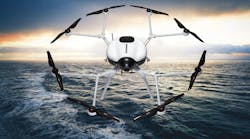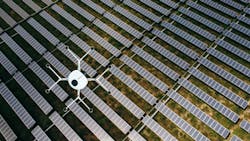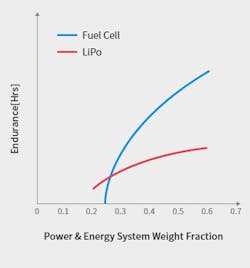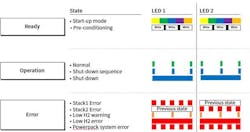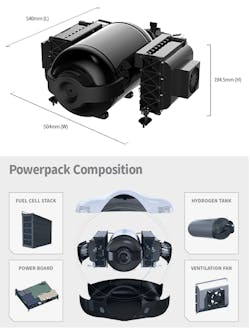Fuel-Cell-Powered Drones to Fly Long-Duration Humanitarian, Commercial Missions
A new breed of commercially available long-range drones uses hydrogen fuel cells to provide the energy they need to deliver humanitarian relief to disaster victims in remote locations up to an hour's flight from their home base. The eight-motor DS30 drone, built by Doosan Mobility Innovation (DMI), is powered by a 2.6-kW fuel cell, also built by DMI.
The DS30 can fly at speeds of up to 80 km/h and operate for up to two hours between refueling when lightly loaded. Even when carrying up to 5 kg worth of equipment, medical supplies, or other vital cargo, they have demonstrated range and endurance that enabled them to transport masks and emergency supplies between U.S. Virgin Islands and deliver medical AEDs to the top of Mt. Hallasan (6,388 ft.), the tallest mountain in South Korea (Fig. 1).
1. DMI drones made long over-water flights to deliver emergency medical supplies in the Virgin Islands. A hydrogen fuel-cell power pack made this possible by enabling over two hours of UAV flight time—four times longer than most battery-powered drones.
Since their recent introduction, DMI's extended-range drones have found several other commercial applications, such as monitoring of vast solar farms, including Korea’s largest solar energy plant in Solasido, Haenam (Fig. 2). Thanks to energy densities that are four to five times greater than what's available from today's batteries, DMI's drones can complete the inspection without refueling. In contrast, a battery-powered drone would require more than six battery replacements to accomplish the task.
2. Solar-panel inspection is achieved with far great efficiency and speed by DMI drones. Using a hydrogen-fuel-cell drone equipped with a common camera and a thermographic camera, the image of a power plant on a site of about 20 MW was obtained by just two automatic grid flights. When performing the same mission using a battery-powered drone, more than six battery replacements are required.
As we shall see, the engineering that enables the drones to accomplish these feats is almost as impressive as the lives they have saved.
From the Moon to the Earth: Optimizing Fuel Cells for Flight
Hydrogen fuel cells have been around since the 1960s and were used to power the spacecraft used in the Apollo lunar missions. Since then, various types of ceramic, membrane-based, and other fuel-cell technologies have begun to find commercial applications in stationary generation systems and limited use in automotive power. However, until recently, the weight and cost of these systems remained impractical for aviation.
While the energy density (Wh/kg) of compressed hydrogen itself is far greater than that of any lithium-based battery available today, the weight of the fuel cells needed to produce the power had made hydrogen-powered aviation difficult (Fig. 3). But since DMI had been developing and manufacturing stationary fuel cells and the electro-materials that power them for many years, they felt they could use their experience to "tip the scales" in favor of hydrogen.
3. Energy density comparison: hydrogen fuel cell vs. lithium batteries.
Modular Hydrogen Power
DMI's design team recognized that creating a cost-effective hydrogen fuel cell for mobile devices would require several technological innovations. Since added weight and volume have a direct impact on a drone's performance, the design team focused on developing a very compact cell stack with the highest possible energy density.
Some of the savings were achieved by using a proprietary ultra-thin metal deposition process to fabricate the cell's bipolar plates, which take up the largest portion of the stack's weight. The lightweight fuel cell also uses a membrane electrode assembly (MEA), which enables lower weight, high energy output, and durability.
The power pack's operation is managed by a compact controller module that automatically performs the stack's startup/shutdown sequences, as well as management, monitoring, and protection functions. It also controls a pair of cooling fans to help keep its operating temperature stable across a wide range of operating conditions.
During startup, the controller performs several processes including “purging,” which cleans out any impurities that could damage the membrane, and gradually introduces hydrogen to gently bring the cells up to operating temperature. During the sequence, an LED display at the rear of the power pack keeps the user informed of the cell's progress (Fig. 4). The controller performs a similar sequence to ensure a safe shutdown.
4. The fuel-cell management board's status display allows the operator to monitor the progress of the stack's startup and shutdown sequences, its operational status, and any malfunctions that might occur.
DPI's power pack also includes a removable, safety-certified, high-pressure (350 bar) 10.8-liter storage tank that can store up to 300 g of hydrogen, providing energy densities that are three to four times higher than today's batteries. The carbon-composite reinforced tank can be removed and replaced in under a minute during refueling operations.
Another one of the key elements in the DP30 power pack's overall design is the system's power delivery network (PDN) that converts the fuel cells' highly variable output voltage (40 to 74 V) to tightly regulated voltages for the propulsion and fuel-cell management systems. The PDN is comprised of two separate powertrains. The first can deliver up to 12 A of 48-V power to the drone's rotor motors while the other provides up to 8 A worth of 12-V power to the stack controller board and its cooling fans.
To achieve the high levels of efficiency and energy density required for the PDN subsystem, DMI selected pre-regulator modulation (PRM) buck-boost regulators and a zero-voltage-switching (ZVS) buck regulator, both manufactured by Vicor. As shown in Figure 5, the PRMs can accept input voltages across the fuel-cell stack's full operating range, up to its 74-V open circuit voltage (OCV), while providing a tightly regulated 48-V output.
5. The DM-30 power module integrates a fuel-cell stack, a removable fuel tank, cell-management electronics, and power-conditioning electronics.
In the rotor-side leg of the PDN, two PRM buck-boost regulators (PRM48AF480T400A00) are configured in parallel to supply the 12 A required by the rotors (Fig. 6). The PDN leg that feeds the fuel-cell controller board electronics' 12-V main bus uses a lower-power PRM (PRM48AH480T200A00) followed by a ZVS buck regulator (PI3546-00-LGIZ).
6. To achieve the high levels of efficiency and energy density required for the PDN subsystem, Vicor PRM buck-boost regulators and a ZVS buck regulator were implemented. The PRMs can accept input voltages across the fuel-cell stack's full operating range, up to its 74-V open circuit voltage (OCV), while providing a tightly regulated 48-V output.
The power pack can also be equipped with hybrid batteries to provide the extra power needed during takeoff and landing, and to serve as a backup power system in the event of a fuel-cell malfunction. If the stack's current suddenly drops, the converter keeps its output within safe limits and prevents damage by supplementing the stack's output with the hybrid batteries. In the event of a complete stack failure, the battery can enable an emergency landing with up to three minutes of operational power.
Expanding the Power Continuum
In response to the success of the DP30 2.6-kW power pack currently in production, DMI plans to expand its product line with several other units, designed to serve a wider range of applications. The family will range from the 1.5-kW hydrogen fuel-cell power pack that’s scheduled to be released next year to a unit capable of producing up to 10 kW. DPI also intends to further expand its product line with a series of drones, each designed to be easily integrated with one of the new power packs.
Learn More
To learn more about DMI's line of drones, fuel cell power packs, and hydrogen storage tanks, click here. To find out more about Vicor’s power-conversion components, and how they’re used in this application, click here.
